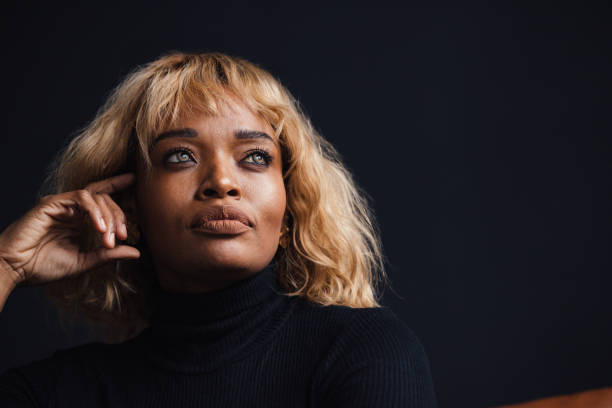Wigs have long been a staple in the world of Black women’s fashion, with roots that stretch deep into the vibrant cultures of ancient Africa. But these aren’t your average fashion accessories—they’ve been symbols of identity, status, and creativity. In ancient African societies, wigs and intricate hairstyles were like living pieces of art. Whether it was showcasing a woman’s age, marital status, or tribal heritage, each carefully crafted hairstyle or wig told a story. And forget about the usual hair tools—we’re talking about clay, beads, and even human hair being used to create these stunning looks!
The history of wigs in African and Black women's fashion is rich and multifaceted, tracing back to ancient times when they served as vital cultural symbols. Wigs were not only a fashion statement but also a reflection of social status, tribal identity, and cultural heritage. In many African societies, intricate hairstyles and wigs conveyed significant information about an individual's age, marital status, and regional background.
From the opulent wigs of ancient Egypt, where they symbolized beauty and power, to contemporary styles that blend tradition with modern aesthetics, the use of wigs has continually evolved. These transformations illustrate the dynamic relationship between Black women and their hair, often driven by societal expectations and personal expression.
Different tribes developed distinctive styles, with some using wigs as a sign of wealth and authority. For example, queens and high-ranking women frequently chose elaborate luxury wigs adorned with ornaments. These creations were not just for aesthetics but also held cultural significance within their communities. Engaging with the history of wigs reveals much about the resilience and creativity of Black women in navigating and redefining their beauty standards. Exploring these cultural nuances invites a deeper understanding of how fashion can intersect with identity and history.
The Colonial Era: Damaging Identity and Forced Adaptation
The transatlantic slave trade drastically impacted hair practices among African and Black women. This period saw a forced adaptation to colonial rules, affecting cultural identity and expression. During the transatlantic slave trade, many African women faced the brutal reality of having their hair forcibly cut or shaved. This act was intended to strip them of their identity and cultural roots. In response, some women began to use wigs and other hair coverings as a means of reclaiming their identity. Wigs offered a way to conform to European beauty standards while restoring a sense of dignity. These practices allowed enslaved women to navigate colonial societies, often using wigs as symbols of status and resistance. The choice of wigs also indicated various social standings, as some styles mirrored the European fashion trends of the time.
Cultural Resilience And Adaptation
Wigs became a vital tool for cultural resilience among Black women during this challenging period. Many embraced hair coverings not only as a form of personal expression but also as a means of maintaining a connection to African heritage. As women learned to create and style wigs, they infused these practices with cultural significance. Braiding, for instance, often incorporated traditional African patterns, allowing women to adapt while retaining aspects of their heritage. This dual purpose—conforming to colonization while preserving culture—highlighted the ingenuity and adaptability of Black women. Wigs transformed into symbols of both survival and defiance, showcasing the complex interplay between oppression and creativity.
Evolution Of Wig Fashion In The African Diaspora
Wig fashion in the African diaspora reflects a complex interplay of cultural identity and external influences. This section explores how wigs have shaped and been shaped by the identities of Black women, as well as the pressures of Western beauty standards that have informed these choices.
The Role Of Wigs In Black Women’s Identity
Wigs have been significant in Black women’s lives, serving as a tool for expressing individuality and cultural heritage. Their use can be traced back to ancient Egypt, where wigs symbolized status and beauty. In the African diaspora, wigs enable women to embrace versatility in hairstyles and self-presentation. This adaptability allows for personal expression while also challenging societal norms. Wigs often serve as a means of reclaiming identity and promoting self-empowerment. By wearing wigs, many Black women assert their beauty on their own terms, which can foster confidence and pride.
Influence Of Western Beauty Standards
The influence of Western beauty standards has profoundly impacted wig fashion among Black women. As European ideals of beauty became more dominant, many Black women turned to wigs to conform to these standards and gain social acceptance. During the 20th century, particularly in the 1940s and beyond, the popularity of synthetic wigs favored styles that mimicked Eurocentric hair textures. This trend highlighted a complex relationship with beauty, often reflecting a desire for approval in predominantly Western contexts. Conversely, the rise of natural hair movements in recent years has encouraged a re-evaluation of wig use among Black women. Wigs are now embraced not just for conformity but also as a celebration of personal style and heritage, demonstrating an evolution in their cultural significance.
Wigs In Contemporary Black Women’s Fashion
Contemporary black women's fashion has seen a significant evolution in wig styles, symbolizing both personal expression and cultural significance. The modern wig industry thrives, reflecting innovative trends, representation in media, and entrepreneurial opportunities.
Trends In Modern Wig Styles
Modern wig styles for black women highlight versatility and personal flair. Synthetic and human hair wigs come in various textures, lengths, and colors, allowing for extensive customization. Popular styles include:
- Lace Front Wigs: Offer a natural appearance and versatile styling options.
- Full Lace Wigs: Provide freedom to part hair anywhere, enhancing authenticity.
- Wigs with Natural Curl Patterns: Embrace and celebrate natural textures, such as afros and curls.
Fashion influencers and celebrities often showcase innovative designs, driving trends that circulate on social media platforms, making them accessible to a broader audience.
Representation In Media And Pop Culture
Representation of black women in media has greatly impacted the perceptions of wigs. Celebrities like Beyoncé and Nicki Minaj frequently don wigs in their public appearances, showcasing their adaptability and style. Television and film also reflect this shift. Characters often wear wigs that celebrate black culture, which help normalize their use. This shift has led to a broader acceptance and appreciation of wigs as a fashion statement, allowing black women to embrace their identity.
Entrepreneurship And The Wig Industry
The wig industry has become a significant source of entrepreneurship for black women. Many have recognized the growing demand for versatile and high-quality wigs, leading to a surge in small businesses. Notable elements include:
- Online Wig Retailers: Many entrepreneurs sell directly through platforms like Instagram and Shopify.
- Custom Wig Services: Bespoke options cater to individual preferences, blending fashion with personal identity.
- Wig Care Products: The market for care products designed for wigs has expanded, providing another avenue for business.
This entrepreneurial spirit empowers black women, fostering economic independence and self-expression through fashion.
The Cultural And Social Impact Of Wigs
Wigs play a significant role in the cultural and social dynamics of African and black women. They serve as a medium for personal expression and foster community ties, reflecting deeper narratives that extend beyond mere aesthetics.
Personal Expression And Empowerment
Wigs provide an avenue for personal expression, allowing women to explore various identities and styles. They can transform appearance, instilling confidence and a sense of empowerment. Many black women use wigs as a way to celebrate cultural heritage while experimenting with different hairstyles that may not be achievable with natural hair. This versatility allows for creativity in expressing individuality. The act of wearing wigs can symbolize resilience, as women embrace their beauty in ways that challenge societal norms about hair. Wigs also serve as a practical solution to manage hair in various environments, enhancing comfort while maintaining style.
Community And Social Acceptance
The use of wigs has deep roots in community identity and social acceptance. In various African cultures, specific hairstyles, including wigs, signify social status and group belonging.Wearing wigs often fosters a sense of solidarity among women, creating spaces for shared experiences and support.
Events such as hair shows and community gatherings celebrate these styles, reinforcing cultural ties and promoting collective empowerment. This communal aspect helps women feel accepted and empowered within their social groups, actively shaping cultural narratives around beauty and self-expression.
Empowerment and Identity: Wigs as a Statement of Power
Wigs have come to symbolize so much more than just beauty—they represent empowerment, resilience, and an unapologetic celebration of Black identity. Whether it’s a full-bodied afro, a sleek bob, or cascading goddess braids, wigs allow Black women to embrace whichever version of themselves feels most authentic at the moment. In conclusion, the journey of wigs in Black women’s fashion is nothing short of epic. From their origins in ancient African culture to their role in today’s diverse and inclusive beauty scene, wigs have been a tool for self-expression, adaptation, and reinvention. It’s a history that celebrates resilience, empowerment, and the ever-evolving nature of style.



















